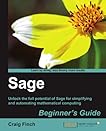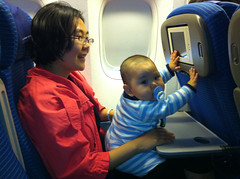 T was a good flyer.
T was a good flyer. He did not fuss beyond what is normal for going to bed at night. Actually, he spent a lot of the flights smiling at our neighbors and the flight attendants. One of the flight attendants wanted to hold him while we were on the ORD-NRT leg of the trip. (no, we did not let her try) 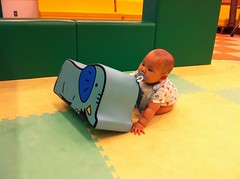 We loved Narita Airport (Tokyo). They have great family bathrooms with very large changing tables and a seat for a baby in the bathrooms. They also have these fun play areas everywhere.
We loved Narita Airport (Tokyo). They have great family bathrooms with very large changing tables and a seat for a baby in the bathrooms. They also have these fun play areas everywhere.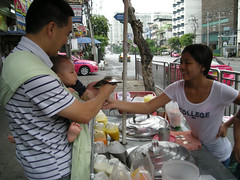 Every day I took T to the market to get breakfast. Sometimes with someone, sometimes not. By the end of the trip, lots of people on the street in the morning were used to seeing him. Many regularly said hello. I think that one of the biggest things from this trip was exposing T to a new environment, new people, new sights, new sounds, new smells.
Every day I took T to the market to get breakfast. Sometimes with someone, sometimes not. By the end of the trip, lots of people on the street in the morning were used to seeing him. Many regularly said hello. I think that one of the biggest things from this trip was exposing T to a new environment, new people, new sights, new sounds, new smells.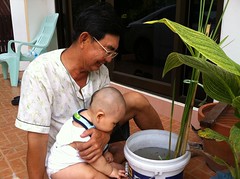 One comment we got everywhere we went was how big his eyes were. Because everywhere I took him, he would be looking around at things and looking at people. Highly attentive.
One comment we got everywhere we went was how big his eyes were. Because everywhere I took him, he would be looking around at things and looking at people. Highly attentive.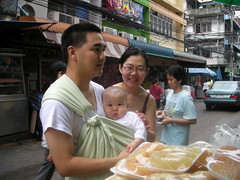 I carried him everywhere in a baby carrier, specifically a Maya Wrap Ring Sling. I could not imagine using a stroller on Thai streets with the pollution and various bugs and animals on the ground. We also noticed that in the sling, T could look at what he choose, which could mean looking ahead or behind. And he could choose to look at people (or not). Those he rewarded with his attention were obvious because of their happy smiles (and his too). It made it real easy to just talk to people who T spotted first.
I carried him everywhere in a baby carrier, specifically a Maya Wrap Ring Sling. I could not imagine using a stroller on Thai streets with the pollution and various bugs and animals on the ground. We also noticed that in the sling, T could look at what he choose, which could mean looking ahead or behind. And he could choose to look at people (or not). Those he rewarded with his attention were obvious because of their happy smiles (and his too). It made it real easy to just talk to people who T spotted first. Of course, the other major reason was so he could see great-grandma. And we were not the only ones. There was another cousin coming in from Chicago whose daughter had never been to Thailand either. And another family from Singapore with two more children. A big family reunion.
Of course, the other major reason was so he could see great-grandma. And we were not the only ones. There was another cousin coming in from Chicago whose daughter had never been to Thailand either. And another family from Singapore with two more children. A big family reunion.- Oh yeah, lots of cousins to play with. This is actually pretty important because T does not get much exposure to playing with other kids. So this was a good way of doing it.
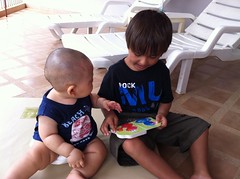

One of the big questions about traveling with a baby is if it is worth it compared to the difficulty. Some thoughts:
- Traveling with children is easier in Asia than in the U.S., because the U.S. culturally makes it unnecessarily difficult. One writer describes it as "not socially acceptible to be human." There are a number of practices in the U.S. that are a based on a desire NOT to make it easier on parents (because the attitude is that conveniences and services must be paid for) that have the effect of making things worse for everyone. In Asia, babies and small children are pretty much welcomed everywhere we went. Granted, I also never saw out of control children in Asia, but part of that is because there is space for them that is not as controlled as in the U.S.
- While the purpose was for the benefit of the grandparents/great-grandparents, I think that T benefited from the trip (even if he does not remember it). He was exposed to many new people, new sights, new sounds, and new experiences. Before he had significant stranger anxiety and was easily scared. So being exposed to so many new things while in the safety of us (parents) holding him may help in this respect.
- T does not get many opportunities for playing with other kids. So being in repeated contact with his cousins in Thailand was a growing experience.
- T really likes being with mom and dad. Dr. Sears describes this as a characteristic of high-need babies (see www.askdrsears.com for what this means). This trip means he had pretty much 24/7 contact with us for the two weeks. So he was a very happy baby pretty much all the time. And development is supposedly faster when a baby is not wasting effort fussing.
We are very glad we did this trip. In the few days we have been back, T has started crawling in earnest (he started while in Thailand). Everyone tells us that traveling becomes much harder from now until he learns how to read, so it may be a while before we do something this involved again.
